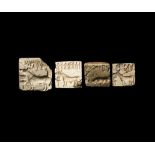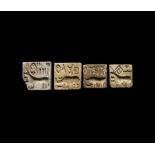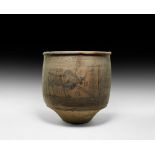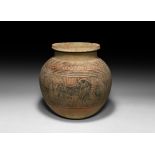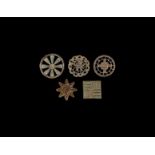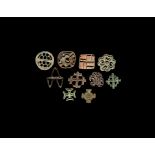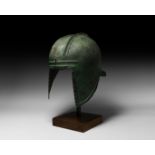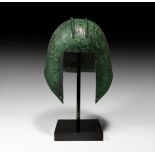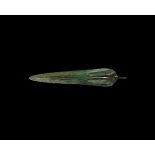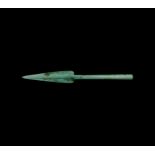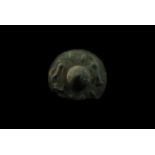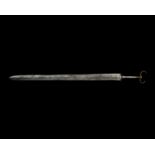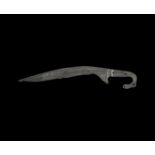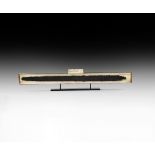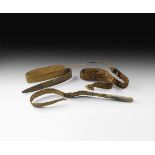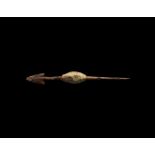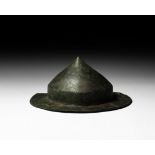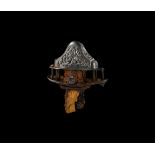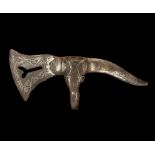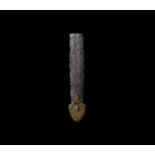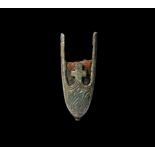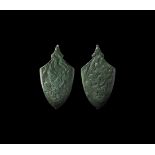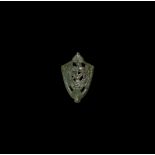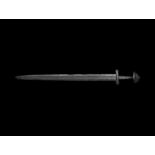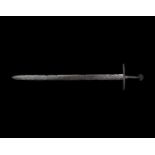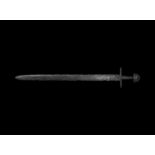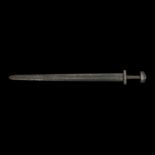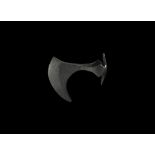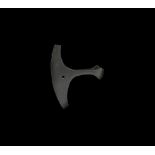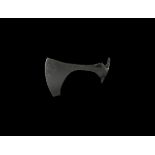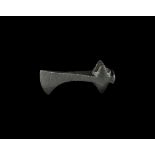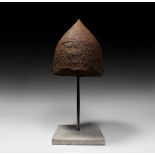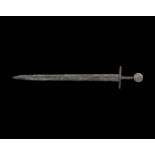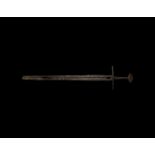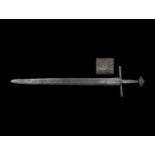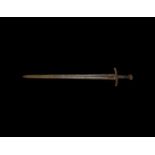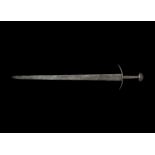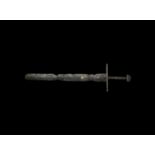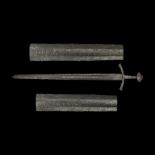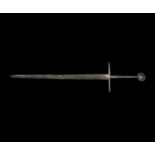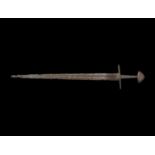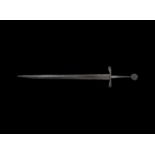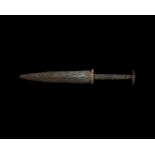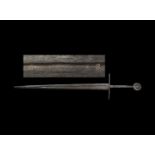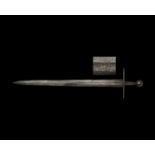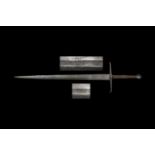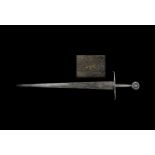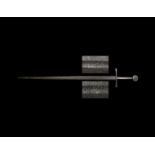Refine your search
Estimate
Category
- Jewellery (132)
- Arms, Armour & Militaria (71)
- Greek, Roman, Egyptian & Other Antiquities (53)
- Chinese Works of Art (52)
- Sculpture (47)
- Collectables (31)
- Metalware (21)
- Ceramics (19)
- Salvage & Architectural Antiques (18)
- Taxidermy & Natural History (17)
- Books & Periodicals (14)
- Coins (14)
- Glassware (12)
- Furniture (9)
- Islamic Works of Art (7)
- Vintage Fashion (6)
- Sporting Memorabilia & Equipment (5)
- Textiles (5)
- Indian Works of Art (4)
- Lighting (4)
- Scientific Instruments (4)
- Musical Instruments & Memorabilia (3)
- Classic Cars, Motorcycles & Automobilia (2)
- Models, Toys, Dolls & Games (2)
- Silver & Silver-plated items (2)
- Ethnographica & Tribal Art (1)
- Prints (1)
- Russian Works of Art (1)
- Stamps (1)
Filtered by:
- Lots with images only,
- Item Type
- List
- Grid
A subscription to the Price Guide is required to view results for auctions ten days or older. Click here for more information
26th-19th century BC. A group of four ceramic rectangular stamp seals with ribbed suspension loops comprising: three with an image of a long-horne...
26th-19th century BC. A group of four ceramic rectangular stamp seals with ribbed suspension loops comprising: two with an intaglio image of a lon...
3rd-2nd millennium BC. A terracotta storage jar with carinated base and chamfered rim, frieze of painted panels with zebu, fronds and fish. 5.6 k...
3rd-2nd millennium BC. A ceramic bowl with painted frieze including a lion and goat on a hatched field, geometric frames. 3.4 kg, 26.5cm (10 1/2"...
2nd millennium BC. A ceramic bowl with basal ring and slightly inturned rim, inner face with applied white petal design and comb motifs with three...
2nd-4th century AD. An amethyst plaque with chamfered rim, intaglio facing bust of a bearded male with abundant hair and draped tunic; accompanied...
Late 3rd millennium BC. A thick bronze stamp seal with dentilled rim and loop handle; accompanied by an old scholarly note, typed and signed by W....
Indus Valley Stamp Seal with Ram
3rd millennium BC. A bronze stamp seal with tapering ribbed handle to the reverse, shaped as a ram standing in profile, compartments to the face. ...
23rd-20th century BC. A mixed group of five bronze seals, all accompanied by typed and signed notes by the late W.G. Lambert, Professor of Assyrio...
23rd-20th century BC. A mixed group of five bronze seals, including four accompanied by typed and signed notes by the late W.G. Lambert, Professor...
Late 3rd-early 2nd millennium BC. A mixed group of bronze stamp seals, some accompanied by an old scholarly note, typed and signed by W.G. Lambert...
Late 3rd-early 2nd millennium BC. A mixed group of bronze stamp seals, some accompanied by an old scholarly note, typed and signed by W.G. Lambert...
Late 3rd-early 2nd millennium BC. A mixed group of mainly bronze stamp seals, some accompanied by an old scholarly note, typed and signed by W.G. ...
Greek Illyrian Bronze Helmet
Mid 6th-5th century BC. A bronze archaic period helmet raised from a single sheet, the bowl of domed form with two parallel corrugated ribs to the...
Greek Illyrian Bronze Helmet
Late 6th century BC. A bronze archaic period helmet raised from a single sheet, the bowl of domed form with two parallel corrugated ribs to the up...
2nd millennium BC. A broad leaf-shaped blade with rounded shoulders and short tang, raised midrib with deep fuller and curved ends extending to th...
Greek Socketted Spearhead
5th-3rd century BC. A bronze spearhead with short triangular two-edged blade, long expanding socket with attachment piercings. 352 grams, 42.5cm ...
9th-6th century BC. A bronze shield boss with domed conical centre, a frieze of running animals surrounding with quadrupeds and a gazelle. 107 gr...
5th-4th century BC. A sheet bronze girdle in two sections with repoussé band to each long edge enclosing a panel of running spiral swirls; mountin...
Iron Age Celtic La Tène Sword
3rd-2nd century BC. An iron sword with wide double-edged blade, raised middle ridge to both sides and rounded tip, long tang and conical pommel wi...
3rd-2nd century BC. A single-edged machaira sword of falcata typology, the hilt formed as a gracefully curving horse's head and neck, the blade wi...
2nd-1st century BC. A substantial long iron currency bar in the shape of a sword with the original short folded-over handle to one end; displayed ...
2nd-1st century BC. A group of three sacrificed iron weapons comprising: a spearhead with long leaf-shaped blade and tubular socket, blade end ben...
Roman Military Plumbata
4th-5th century AD. A plumbata (or martiobarbuli) iron dart with barbed head and short shank, bulb of lead below the head. See discussion in Bisho...
Roman Shield Boss
1st century BC-2nd century AD. A sheet bronze shield boss with circular flange, low sidewall and conical centre; pierced in three places for attac...
6th century AD. A scabbard mount for the sheath of a knife comprising: a bell-shaped bronze plaque and applied panels with ring-and-dot ornament; ...
5th-6th century AD. A square-section iron snaffle-bit with two straight silver-gilt cheek-pieces with transverse grooves and kidney-shaped loop, r...
6th century AD. A sword pommel, upper guard and associated portion of the iron tang; the pommel of cocked-hat type in sheet silver with a panel of...
8th-10th century AD. An iron axehead with tubular socket and languettes, curved blade with Y-shaped void, inlaid silver scrolls and rosette to eac...
Viking Sword Tip with Chape
9th-10th century AD. An iron sword-blade fragment, lentoid in section with slight fuller, the tip housed in a bronze chape of its scabbard; the ch...
Viking Sword Scabbard Chape
11th century AD. A bronze bifacial scabbard chape with heater-shaped body, knop finial, extended lateral arms and cross between, incised Jellinge ...
Viking Jellinge Sword Chape
10th century AD. A bronze chape for a sword scabbard, heater-shaped with scooped upper edge and bear-head finial, low-relief Jellinge style tendri...
Viking Jellinge Sword Chape
10th century AD. A bronze chape from a sword's scabbard, heater-shaped with knop finial and scooped upper edges, openwork Jellinge style ornament ...
Viking Single-Handed Sword
10th-early 11th century AD. A double-edged sword of Petersen Type S variant with tapering blade, shallow fullers, possible traces of pattern-weldi...
Viking Single-Handed Sword
Early 10th-mid 11th century AD. A single-handed sword of Petersen Type X and Oakeshott Type X with tapering blade, shallow fullers and strong cutt...
Viking Single-Handed Sword
Early 10th-mid 11th century AD. A single-handed sword of Petersen Type X with tapering double-edged blade, well-defined shallow fullers, battle ni...
9th century AD. A double-edged sword of Petersen Type K, Sub Type 8, with broad tapering blade, shallow fullers, boat-shaped crossguard inlaid wit...
Viking Hook-Billed Broad Axehead
9th-11th century AD. An iron axehead with long, deeply curved blade, short neck, round socket with lateral triangular spurs and long rectangular e...
9th-12th century AD. An iron axehead with broad curved edge, blade pierced at the centre, slender neck, round socket with lateral wings to each si...
9th-11th century AD. A large iron axehead with wide sweeping blade, chin to the lower edge, long rectangular-section neck; round socket with later...
Heavy Viking Long Axe-Hammer
9th-11th century AD. An iron axehead with long sturdy neck and narrow curved blade; round socket with lateral triangular flanges, rectangular hamm...
Francisca Bowed Axehead
5th-8th century AD. A socketted triangular-section iron francisca axehead with broad curved cutting edge and elliptical socket. Cf. Nice, A., Revu...
Norman Spangenhelm Helmet
8th-11th century AD. A Norman or Viking period two-plate iron helmet, skilfully made to accommodate the curvature of the human head and with a poi...
Norman Single-Handed Sword
12th-early 13th century AD. A well-balanced Oakeshott Type XI sword with double-edged blade, shallow fuller and solid tip; straight lower guard, m...
12th century AD. A hand-forged iron sword comprising a narrow two-edged blade with shallow fuller to both faces, short ricasso, slender square-sec...
Norman Long Sword with Inlay
Mid 10th-late 12th century AD. A long double-edged sword of Oakeshott Type Xa and Petersen Type X with tapering elegant blade, shallow fullers run...
Norman Single-Handed Sword
12th century AD. A hand-forged iron sword with slender blade and shallow fuller to each face, shallow point, gently curved rectangular-section cro...
Norman Double-Edged Long Sword
Late 11th-mid 13th century AD. An iron double-edged sword of Oakeshott Type Xa with a thin, elegant blade allowing good handling, shallow fuller a...
11th-12th century AD. An iron two-edged sword with broad two-edged lentoid-section blade, slightly tapering square-section crossguard. flat tang, ...
12th-14th century AD. A well-balanced long double-edged sword of Oakeshott's Type XI, the blade showing evidence of use on the battlefield; one si...
1270-1330 AD. An iron bastard sword of Oakeshott Type XIIIA with long tapering blade, narrow fuller divided into two parallel lines; straight lowe...
Mid 12th-mid 13th century AD. An iron double-edged long sword of Oakeshott Type Xa and Petersen Type X with pattern-welded blade, visible fullers,...
1308-1400 AD. An iron bastard or a hand-and-a-half sword of Oakeshott Type XVIa, probably a marriage; long tapering blade with later fullers; the ...
12th-14th century AD. A hand-forged iron triangular blade, lentoid in section with shallow tip, broad tang and slender D-shaped pommel; bronze bal...
Late 13th-early 15th century AD. A beautifully balanced hand-and-a-half sword of Oakeshott Type XIIa with double-edged blade, long central fuller ...
Early 14th century AD. An iron long sword of Oakeshott Type XVIa with tapering blade and well-marked fuller; curved crossguard of style 6, oval po...
Medieval Inlaid Long Sword
Early-mid 14th century AD. A Western long double-edged sword of Oakeshott Type XIIIb with elegant, broad blade, distinctively widening below the h...
1430-1450 AD. An iron long sword of Oakeshott Type XVIa or XVIIIa with a long acutely pointed blade of flattened diamond-section form, well-marked...
Early 14th-early 15th century AD. A single-handed sword of Oakeshott Type XV with acutely pointed blade, shallow fullers with inlaid latten maker'...
14th century AD. An iron sword of Oakeshott Type XVIa with slender two-edged blade, lentoid-section lower third with a shallow fuller to the upper...

